#continental climate
Text
Parajes del Valle

Parajes del Valle
Monastrell Ecologico
Jumilla, Spain
2022
Monastrell / Mourvédre
This is a fresh and floral style chilled red from the southeast Spain - a predominantly continental climate. Here it is sunny and arid with more than 300 days of sunshine per year and very limited rainfall. With very hot summers and very cold winters, these conditions are optimal for Monastrell - high alcohol, ripe jammy fruits, rich flavours and textbook spice.
Hand harvested and aged for 8 months in concrete, this chilled red has piercing clean acidity and young grippy tannins.
Whilst the winery may be young, established in 2018, the winemakers’ views are anything but. They work closely with local farmers to preserve the existing farming cooperative. They entrust the farmers with old vines 15-40 years old of Monastrell across four different plots hence the name - Parajes del Valle.
Monastrell / Mourvèdre
Predominantly grown in Spain, it is a superb value grape that does not require ageing. Characterised by high tannins, high alcohol, high acidity and being very fruit forward. Dominant flavours are blackberry, black pepper, cocoa, sweet tobacco and roasted meats.
Tasting notes: Bright, piercing red cherry, redcurrants, cherry, plum, cranberry, raspberry, green pepper spice, fresh tobacco, cardamom, dried Mediterranean herbs, vanilla, chocolate
Pairing: roasted/grilled beef and lamb, pasta, hard and blue cheese
#Parajes del Valle#Monastrell#jumilla#Spain#2022#continental climate#concrete#old vines#mourvedre#beef#lamb#pasta#hard cheese#blue cheese#wotw#cherry#redcurrants#plum#green pepper#cardamom#oregano
0 notes
Text
"white christmas is anglocentric" gave me psychic damage. ah yes england. well known for its extreme weather patterns like snow in winter and extreme heat in summer. that england.
me when all i know about weather is "north cold, south not cold"
#THE BRITISH ISLES HAVE OCEANIC CLIMATE#OCEANIC CLIMATE MEANS A NARROW ANNUAL RANGE OF TEMPERATURES#CONTINENTAL EUROPE HAS MUCH BIGGER VARIATION OF TEMPERATURE THAN THAT.#SORRY FOR YELLING.
24 notes
·
View notes
Text
50 Million Years of Climate Change with Christina!
Have you ever thought about how dinosaurs lived on a warm, swampy Earth and how we live on one that’s cold enough to keep pretty much the entirety of Greenland and Antarctica buried under kilometers-thick sheets of solid ice and wondered, hmm, how did we get from there to here? The short answer is that it took 50 million years of declining atmospheric carbon dioxide concentrations and dropping temperatures, not to mention building an ice sheet or two. For the longer story of the last 50 million years of climate change, including some of the reasons why, catch this episode of our podcast with Dr De La Rocha! You’ll hear about plate tectonics and continental drift, silicate weathering, carbonate sedimentation, and the spectacular effects the growth of Earth’s ice sheets have had on Earth’s climate. There are also lessons here for where anthropogenic global warming is going and whether or not its effects have permanently disrupted the climate system. Fun fact: the total amount of climate change between 50 million years ago and now dwarfs what we’re driving by burning fossil fuels, and yet, what we’re doing is more terrifying, in that it’s unfolding millions of times faster.
Bonus content: If you want to see sketches and plots of the data discussed in this episode, you can do so here!
!!Nerd alert!!
If you're interested in the primary scientific literature on the subject, these four papers are a great place to start.
Dutkiewicz et al (2019) Sequestration and subduction of deep-sea carbonate in the global ocean since the Early Cretaceous. Geology 47:91-94.
Müller et al (2022) Evolution of Earth’s plate tectonic conveyor belt. Nature 605:629–639.
Rae et al (2021) Atmospheric CO2 over the last 66 million years from marine archives. Annual Review of Earth and Planetary Sciences 49:609-641.
Westerfeld et al (2020) An astronomically dated record of Earth’s climate and its predictability over the last 66 million years. Science 369: 1383–1387.
Connect with Christina at her blog, on Twitter, and on Mastodon
Support the show on Patreon or make a one-time donation via PayPal.
#climate change#solarpunk presents podcast#ice sheets#climate#plate tectonics#continental drift#silicate weathering#carbonate sedimentation#anthropogenic global warming#global warming#climate system#science
10 notes
·
View notes
Text
when @beatifiq and i were in costa rica i was living off of fresh local tropical fruits and coffee that was the best i’ve ever had
#and although that sounds like potion of shit yourself i’ve literally never pooped better in my life i need to go back#born in a temperate continental climate but build for dry tropical
4 notes
·
View notes
Text

im fucking MELTING HERE
2 notes
·
View notes
Text
Fun fact, I also live on an island, so in a sense this is very much the kind of shirt I really should be wearing.
#some of my dad's poetry friends are hawaiian#and when they were staying with us they said that our climate was much more like hawaii than most of the parts of the continental u.s.#that they had visited#so honestly? taking this message to heart
2 notes
·
View notes
Text
There is nothing like looking at climate zone shit to tempt you to scrap an entire map just so you don't have to think about it and can focus instead on the new ones you didn't make the same mistakes on.
#the continental climates tutorial came out#i haven't finished temperate climates yet#it's the same 'now compare summer and winter' shit when i was a moron and decided not to bother doing both#and instead just did averages#i'm not actually gonna scrap shit but damn is it tempting#i won't have these same problems with the next three maps but the ha'n one is gonna kill me here in the home stretch
0 notes
Text
Me: Why is it so cold in the office?
Boss: Oh, I left the window open on Friday because I thought it would get stuffy over the weekend
Me: …
#Boss you and I live in a severely continental climate#The chance of snow and frost in the spring after a week of thaw is higher than you think#madam says
0 notes
Text
hey uh so I haven't seen anyone talking about this here yet, but
the amazon river, like the biggest river in the fucking world, in the middle of the amazon fucking rainforest, is currently going through its worst drought since the records began 121 years ago

picture from Folha PE
there's a lot going on but I haven't seen much international buzz around this like there was when the forest was on fire (maybe because it's harder to shift the narrative to blame brazil exclusively as if the rest of the world didn't have fault in this) so I wanted to bring this to tumblr's attention
I don't know too many details as I live in the other side of the country and we are suffering from the exact opposite (at least three cyclones this year, honestly have stopped counting - it's unusual for us to get hit by even one - floods, landslides, we have a death toll, people are losing everything to the water), but like, I as a brazilian have literally never seen pictures of the river like this before. every single city in the amazonas state is in a state of emergency as of november 1st.
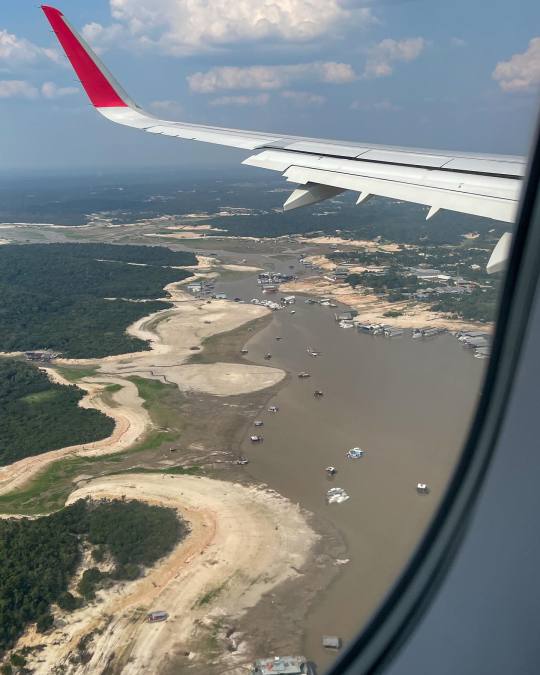

pictures by Adriano Liziero (ig: geopanoramas)
we are used to seeing images of rio negro and solimões, the two main amazon river affluents, in all their grandiose and beauty and seeing these pictures is really fucking chilling. some of our news outlets are saying the solimões has turned to a sand desert... can you imagine this watery sight turning into a desert in the span of a year?

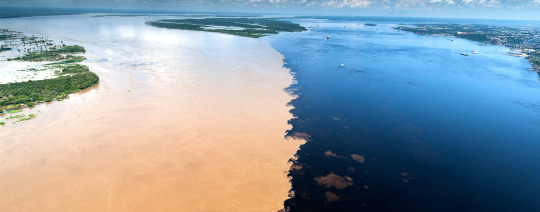
while down south we are seeing amounts of rain and hailstorms the likes of which our infrastructure is simply not built to deal with, up north people who have built everything around the river are at a loss of what to do.
the houses there that are built to float are just on the ground, people who depend on fishing for a living have to walk kilometers to find any fish that are still alive at all, the biodiversity there is at risk, and on an economic level it's hard to grasp how people from the northern states are getting by at all - the main means of transport for ANYTHING in that region is via the river water. this will impact the region for months to come. it doesnt make a lot of sense to build a lot of roads bc it's just better to use the waterway system, everything is built around or floats on the river after all. and like, the water level is so incomprehensibly low the boats are just STUCK. people are having a hard time getting from one place to another - keep in mind the widest parts of the river are over 10 km apart!!
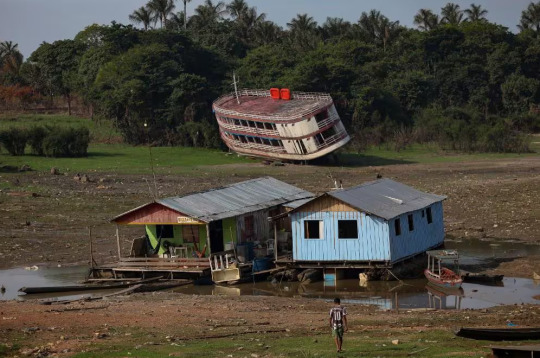
this shit is really serious and i am trying not to think about it because we have a different kind of problem to worry about down south but it's really terrifying when I stop to think about it. you already know the climate crisis is real and the effects are beyond preventable now (we're past global warming, get used to calling it "global boiling"). we'll be switching strategies to damage control from now on and like, this is what it's come to.
I don't like to be alarmist but it's hard not to be alarmed. I'm sorry that I can't end this post with very clear intructions on how people overseas can help, there really isn't much to do except hope the water level rises soon, maybe pray if you believe in something. in that regard we just have to keep pressing for change at a global level; local conditions only would not, COULD NOT be causing this - the amazon river is a CONTINENTAL body of water, it spans across multiple countries. so my advice is spread the word, let your representatives know that you're worried and you want change towards sustainability, degrowth and reduced carbon emissions, support your local NGOs, maybe join a cause, I don't know? I recommend reading on ecological and feminist economics though
however, I know you can help the affected riverine families by donating to organizations dedicated to helping the region. keep in mind a single US dollar, pound or euro is worth over 5x more in our currency so anything you donate at all will certainly help those affected.
FAS - Sustainable Amazon Fundation
Idesam - Sustainable Developent and Preservation Institute of Amazonas
Greenpeace Brasil - I know Greenpeace isn't the best but they're one of the few options I can think of that have a bridge to the international world and they are helping directly
There are a lot of other smaller/local NGOs but I'm not sure how you could donate to them from overseas, I'll leave some of them here anyway:
Projeto Gari
Caritás Brasileira
If you know any other organizations please link them, I'll be sure to reblog though my reach isn't a lot
thank you so much for reading this to the end, don't feel obligated to share but please do if you can! even if you just read up to here it means a lot to me that someone out there knows
also as an afterthought, I wanted to expand on why I think this hasn't made big news yet: because unlike the case of the 2020 forest fires, other countries have to hold themselves accountable when looking at this situation. while in 2020 it was easier to pretend the fires were all our fault and people were talking about taking the amazon away from us like they wouldn't do much worse. global superpowers have no more forests to speak of so I guess they've been eyeing what latin america still has. so like this bit of the post is just to say if you're thinking of saying anything of the sort, maybe think of what your own country has done to contribute to this instead of blaming brazil exclusively and saying the amazon should be protected by force or whatever
#solarpunk#sustainability#environmentalism#climate change#climate crisis#global warming#amazon rainforest#amazon river#geography#brazil#degrowth#punk#global boiling#ecopunk#anti capitalism#climate action#climate activism#the world does not die on my watch#i saw someone use that tag and uh i like it we should make it a thing#long post#:/ sorry i know no one likes lengthy bad news posts on their dashes but i've been thinking about this quite a bit#and i don't really know what to do to help bc i don't have money to donate and i am 10 thousand km away#i think i could be doing more to help but i am already trying my best#again dont feel obligated to share or read this but it would be nice and i would love you forever#have removed lbv from the post
7K notes
·
View notes
Text
Brrrr Not me trying to write Starlight Guilt and then realizing I need to make or research several completely different cultures to get the effect I want
#Starlight Guilt#oiarfoajgoajg#I don't even know where to start :'(#That's a lie#I know I need to start by limiting the species that I'm considering and placing them somewhere on my continental map#and then vaguely applying global earth climate systems to the map so I can feel somewhat satisfied that it's vaugely realistic#I should really just slap it all together real messy like so I can finish the draft and figure out what holes I need to fill#:'(#world building#I have the skeleton#I just need to fill it with flesh
0 notes
Text
youtube
S2.8 is now on YouTube!
Have you ever thought about how dinosaurs lived on a warm, swampy Earth and how we live on one that’s cold enough to keep pretty much the entirety of Greenland and Antarctica buried under kilometers-thick sheets of solid ice and wondered, hmm, how did we get from there to here? The short answer is that it took 50 million years of declining atmospheric carbon dioxide concentrations and dropping temperatures, not to mention building an ice sheet or two.
For the longer story of the last 50 million years of climate change, including some of the reasons why, catch this episode of our podcast with Dr De La Rocha! You’ll hear about plate tectonics and continental drift, silicate weathering, carbonate sedimentation, and the spectacular effects the growth of Earth’s ice sheets have had on Earth’s climate. There are also lessons here for where anthropogenic global warming is going and whether or not its effects have permanently disrupted the climate system. Fun fact: the total amount of climate change between 50 million years ago and now dwarfs what we’re driving by burning fossil fuels, and yet, what we’re doing is more terrifying, in that it’s unfolding millions of times faster.
Bonus content: If you want to see sketches and plots of the data discussed in this episode, you can do so at our website here!!
Nerd alert!! If you're interested in the primary scientific literature on the subject, these four papers are a great place to start:
Dutkiewicz et al (2019) Sequestration and subduction of deep-sea carbonate in the global ocean since the Early Cretaceous. Geology 47:91-94.
Müller et al (2022) Evolution of Earth’s plate tectonic conveyor belt. Nature 605:629–639.
Rae et al (2021) Atmospheric CO2 over the last 66 million years from marine archives. Annual Review of Earth and Planetary Sciences 49:609-641.
Westerfeld et al (2020) An astronomically dated record of Earth’s climate and its predictability over the last 66 million years. Science 369: 1383–1387.
#carbonate sedimentation#silicate weathering#solarpunk#solarpunk podcast#Solarpunk Presents Podcast#Dr Christina De La Rocha#plate tectonics#deep time#climactic system#climate change over millions of years#biogeochemical cycles#biogeochemistry#geological analysis of climate change#carbon dating#global warming#earth sciences#history of climate change#archaeology of climate change#continental drift#what was the climate like for the dinosaurs#youtube#Youtube
7 notes
·
View notes
Text

Not everyone in Malmo was welcoming the Eurovision Song Contest to town.Thousands of pro-Palestinian demonstrators protested in the Swedish port city on Thursday against Israel’s participation in the pan-continental pop competition.Protesters waving green, white, black and red Palestinian flags packed the historic Stortorget square near Malmo’s 16th-century town hall before a planned march through the city for a rally in a park several miles (kilometers) from the Eurovision venue. Police estimated that between 10,000 and 12,000 people took part. Among those in the crowd was Swedish climate activist Greta Thunberg.
Chanting “from the river to the sea, Palestine will be free!” and “Israel is a terror state,” the demonstrators set off smoke flares in the Palestinian colors during a noisy, peaceful rally to criticize Israel and call for a cease-fire.
#yemen#jerusalem#tel aviv#current events#palestine#free palestine#gaza#free gaza#news on gaza#palestine news#news update#war news#war on gaza#rafah#boycott eurovision#bds movement
1K notes
·
View notes
Note
your post about potatoes in fantasy worlds made me base my primary fantasy continent off sudamérica so i could use fantasy versions of andean and amazonian fauna/flora. I'm still trying to figure out how to change the geography enough to have the big desert i want in the right area(andes get an offshoot that encircles a rain shadow desert in the central north is the best idea i have) but actually being forced to consider how native wildlife works and needing to create trade routes if i wanted imported crops was fun. i was also trying to figure out why the southern hemisphere has more hot climates than the north and something said it's because the south on earth has less landmass so i think having the northern hemisphere above it be mostly tropical works if I have mostly archipelagos? also every time i see a european based fantasy have potatoes or tomatoes i shake my head and scowl.
The reason why the Southern Hemisphere seems to have more hot climates is indeed simply because the continental parts don't spread that far South to actually cold southern latitudes. The only place that really sticks that far south to have a truly cold climate is the Patagonia. And of course, Antarctica, which by coinicidence, basically surrounds the South Pole.
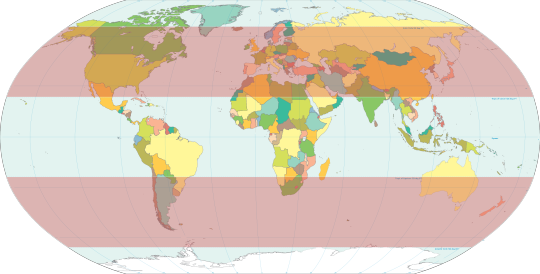
Here is a map of "temperate" latitudes, or rather, latitudes between the tropics and the polar circles (as someone who lives here, or indeed an Australian can tell you, many places there are not "temperate" at all but more on that below). What is important here is that the southern hemisphere has less places closer to the pole, except, again, Antarctica, while the northern hemisphere has lots of land near the poles. This is why we don't have our equivalents of say, Siberia, for example. The closest thing is again, Patagonia. Honestly an underused place for worldbuilding, with the steppe, the glaciers, the temperate rainforests, and the recently extinct megafauna, but I digress.
You could in fact have a tropical "north" if you keep most of the northern hemisphere's landmasses near the equator (here I'm picturing some kind of big Indonesia or Caribbean, an area where tectonic plates collide and there's lots of volcanic islands and lands), and you could place a big continent in the South to make it a cold South. Interesting reversal on the cold North/warm South of most settings.
This would bring some interesting effects, though. Placing a big landmass on any pole (not a small one like Antarctica) would lead to glaciation, as land is "colder" or rather less moderated by ocean (more on that later) and glaciers grow, and glaciers and arid land have greater albedo, reflectivity, that is, and so they reflect more sunlight, thus those place become colder, and the glaciers keep growing, and so on, until there is an ice-age. I don't have the link where I read it with me, but I recall that continents shifting to polar latitudes might have triggered ice-ages in Earth's past.
Deserts are very tricky to place. The standard worldbuilding recommendation is that the interior of the continents are drier as you get away from the sea, and that mountain chains and high terrain serves as rainshadows that stop rain from the sea. However, there is a lot more to it. A LOT more.
You can find deserts even next to oceans, in the so-called "horse latitudes", the meeting points of the Hadley Cells that circulate air from the Equator to the subtropics and beyond. The details are a bit technical, but what this means basically is that they create jet streams of circulating air at 30° South and North, keeping the climate sunny, warm and dry. This is indeed where many of the world's coastal deserts are: Atacama, Kalahari, and of course, Australia.
Meanwhile, in the equatorial zone, the "trade winds" (because they have regular wind patterns that have historical formed major sea trade routes, worldbuilding hint!) converge in the Equator, forming rainy areas... but not quite that simple.
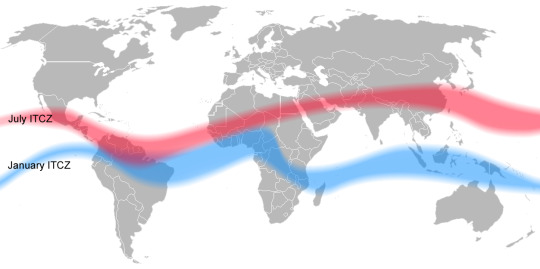
The Intertropical Convergence Zone, where these winds meet, ocsilates during the year, creating monsoons, but as always, there are lots of factors involved. In particular, given our real life scenario of rapid climate change and global warming, a warmer temperature means more intense ocsilations. This makes monsoon events sharper (more droughts and floods in those regions) and more strong La Niña/El Niño events, which are their own thing, influenced by the Pacific which is a huge factor in global climate.
And this brings me to ocean currents. Usually, being close to the ocean moderates the climate, making it more rainy and warm, or at least stable. However, if the surrounding sea is cool, it means less evaporation and less rainfall, especially if it's influenced by cool polar currents (this is the case of eastern Patagonia, for example, with the cold Malvinas Current). The opposite is the case in, for example, Europe, where the warm gulf stream moderates climate, making it warmer and rainer compared to the same latitudes in the US and Canada. I'll admit I'm not very well informed on how ocean currents work, but the depth and salinity of the ocean have much to do with it. What basically happens is that dense salty water sinks and and this works as a "conveyor belt" for warm less dense surface water to flow over it and over great distances. These currents are slow, but since the ocean is so massive, they move extensive amounts of heat across the world. I will admit defeat here and just say I don't wholly understand how it works, but I can tell you this; if your world has a less salty ocean, your currents will be less strong, which means that the differences of temperature between the poles and the tropics will be sharper as there are no strong currents to overall moderate temperature. If this is all too complex for you as it is to me, the quick cheat is just looking at this map: warm water flows from the equator, and cold water flows from the poles, and they create "gyres" around the oceans and the Equator, and cold currents contribute to colder and drier climates (note the Canary, Benguela and Peru currents, the Malvinas current is not shown for some reason...)
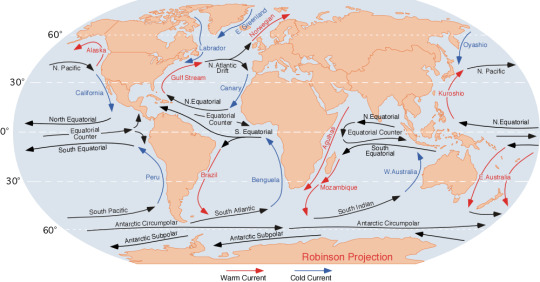
Did I forget something? Oh, yes. A colder climate of course, means less rainfall, because there is less evaporation and there is much water "trapped" in glaciers and snow. Which seems to be the case during the last ice ages. Rainforests and forests in general retreated as deserts expanded. In fact, the few forests that remained served as refugiums for species that only expanded again once the ice age was over. Some especulate that this might meant a 'weakening' of megafauna, as they were trapped in those refuges with lots of interbreeding and weakened populations when humans arrived on the scene. Here is a very interesting map:
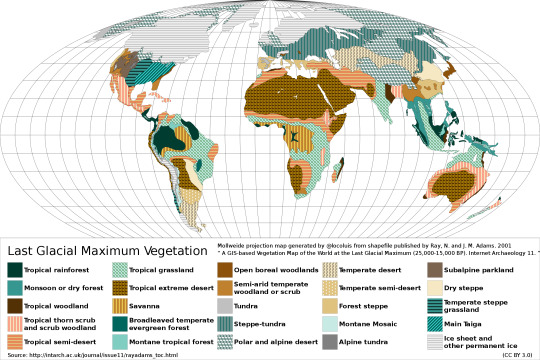
Now, there are some contradictions here and there, some researchers have said that the climate wasn't that dry and while I'm not an expert I tend to agree, many parts that are "extreme desert" there might be scrubland instead. But overall, it seems that colder times bring drier times too.
I'm still not done, but I'm almost done! According to the Biotic Pump theory, forests might also influence the climate and rainfall in a big way, basically, evapotranspiration (plants sweat, a lot, 90% of water through a plant evaporates to the atmosphere) in forests might actually create by itself the rainy environment where forests thrive, so for example, the Amazon is a rainforest BECAUSE of the forest there. I think with the increasing droughts here in South America we're seeing that theory proven in practice, as deforestation of the Mata Atlantica, the Chaco and the Amazon is causing less rainfall in the centre of the continent. Forests and plants also have a cooling effect, since they fix carbon dioxide, and also a bit of a warming effect, since they have darker albedo and so absorb more sunlight. I'm going to be very lazy and instead of reading a thousand papers say that they overall have a "moderating" effect.
Well, I could go on and on but I think I've already written way too much, so I'll leave you this to munch on a bit. It might seem like a lot, but when in doubt, you can always "eyeball" it by comparing real regions of Earth, and it will help you to create more interesting world than the omnipresent "spring-summer-fall-winter" temperate standard in so many settings.
If you have any questions, feel free to ask! Oh, and also, if you found this helpful or interesting, I would appreciate a tip to my ko-fi!
296 notes
·
View notes
Text

Geum triflorum, commonly known as prairie smoke, old man's whiskers, torchflower, three-sisters, long-plumed purple avens, lion's beard, or three-flowered avens, is a spring-blooming perennial herbaceous plant of the Rosaceae family. It is a hemiboreal continental climate species that is widespread in colder and drier environments of western North America, although it does occur in isolated populations as far east as New York and Ontario. It is particularly known for the long feathery plumes on the seed heads that have inspired many of the regional common names and aid in wind dispersal of its seeds. -Wikipedia
158 notes
·
View notes
Text
Venus and Earth seem like twins who, through dramatically different circumstances and choices, ended up leading dramatically different lives.
Earth is bountiful and welcoming, with a soft, safe atmosphere, sloshing oceans, forgiving temperatures, and land masses carpeted with growth. Venus is choked by clouds of toxic gas, rains acid, has crushing atmospheric pressure, and burns with temperatures more befitting Dante's inferno, in the hundreds of degrees.
These differences are more than skin deep. Venus lacks our planet's tectonics, including the large, separate areas of planetary crust that grind against each other and help maintain a stable climate here on Earth, and in which the continental land masses are embedded.
Continue Reading.
78 notes
·
View notes
Text


Working on my creature and headworld stuff, here's some clothing for the warm continental griffs [pearls and corals], and the cold continental griffs [agates]
Rough info under cut

Pearls, Corals and Agates all share a common ancestor, Corals have the closest resemblance to them overall, and Agates diverged waaay further back in time and dispersed up into a colder climate and began to develop more mammalian features (whiskers, fur-like feathers, mammary glands in all sexes as they equally share in nursing due to the less stable weather and food supply)
Pearls diverged a little bit later, but remained on the island chain with Corals. They trade through inland sea passages with Agates, food, culture, tradition, materials, etc.
The primary threat they deal with is simply environmental, large predatory beasties, they aren't necessarily 'top of the foodchain' and are still vulnerable to predation. Thats all I got for u for now.
Corals and Pearls are heavily inspired by Minoan and Ancient Greek fashion and architecture, while Agate are heavily inspired by the 900's Danish Vikings
112 notes
·
View notes